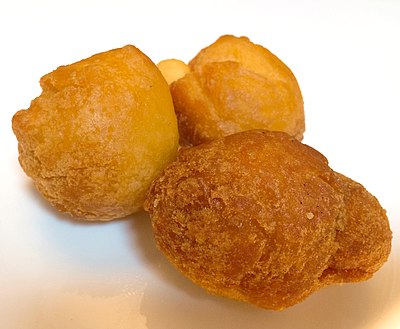
Search
Sata andagi

Sata andagi (サーターアンダーギー, sātā andāgī) are sweet deep fried buns of dough similar to doughnuts (or the Portuguese malassada, or the Dutch oliebollen), native to Southern China, there named sa-yung (Chinese: 沙翁; pinyin: shāwēng; Jyutping: sa¹ jung¹; Cantonese Yale: sā yūng), then spread to the Japanese prefecture of Okinawa. They are also popular in Hawaii, sometimes known there simply as andagi. Sata andagi is made by mixing flour, sugar and eggs. The ingredients are mixed into a ball and deep fried.
In its Okinawan name, Saataa means "sugar", while andaagii means "deep fried" ("oil" (anda) + "fried" (agii)) in Okinawan (satō and abura-age in Japanese.) It is also known as saataa andagii and saataa anragii.
Sata andagi are a part of Okinawan cuisine. Like most confectionery from the Ryukyu Islands, the techniques for making them are descended from a combination of Chinese and Japanese techniques. They are typically prepared so that the outside is crispy and browned while the inside is light and cake-like.
See also
- List of doughnut varieties
- List of fried dough varieties
- Food portal
References
External links
- A simple sata andagi recipe
Text submitted to CC-BY-SA license. Source: Sata andagi by Wikipedia (Historical)
Articles connexes
- List of Japanese desserts and sweets
- Fairy Tail season 5
- SATA (disambiguation)
- Sel roti
- List of desserts
- Fleischkuekle
- Okinawan cuisine
- Shintaro Yamada
- Ryukyuan people
- Doughnut
- List of doughnut varieties
- List of fried dough foods
- List of Yotsuba&! chapters
- Meibutsu
- Kippan
- List of Azumanga Daioh episodes
- A-Nation
- Shankarpali
- Quiz! Hexagon II
- Gwaramari
Owlapps.net - since 2012 - Les chouettes applications du hibou

